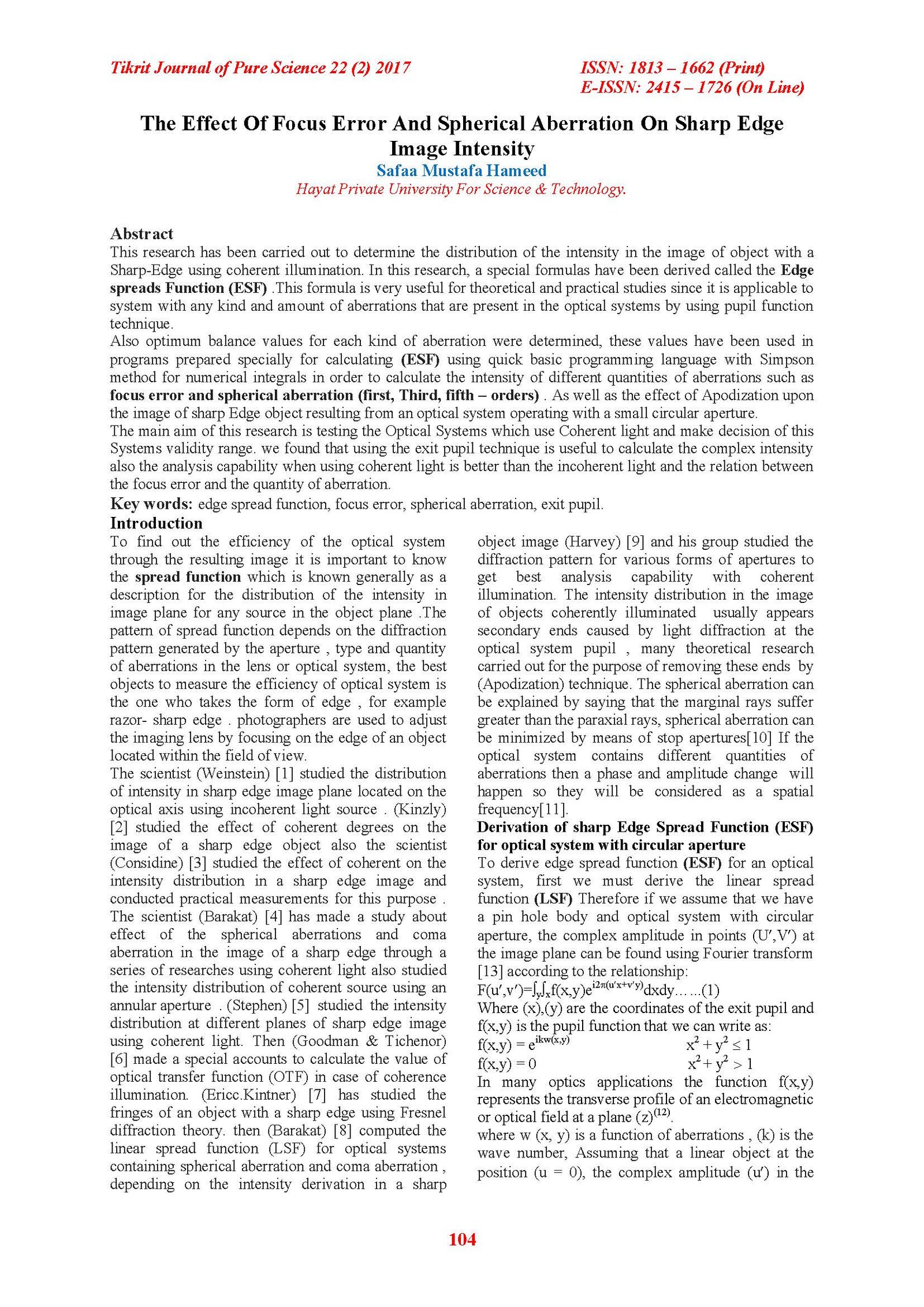The Effect Of Focus Error And Spherical Aberration On Sharp Edge Image Intensity
Main Article Content
Abstract
This research has been carried out to determine the distribution of the intensity in the image of object with a Sharp-Edge using coherent illumination. In this research, a special formulas have been derived called the Edge spreads Function (ESF) .This formula is very useful for theoretical and practical studies since it is applicable to system with any kind and amount of aberrations that are present in the optical systems by using pupil function technique.
Also optimum balance values for each kind of aberration were determined, these values have been used in programs prepared specially for calculating (ESF) using quick basic programming language with Simpson method for numerical integrals in order to calculate the intensity of different quantities of aberrations such as focus error and spherical aberration (first, Third, fifth – orders) . As well as the effect of Apodization upon the image of sharp Edge object resulting from an optical system operating with a small circular aperture.
The main aim of this research is testing the Optical Systems which use Coherent light and make decision of this Systems validity range. we found that using the exit pupil technique is useful to calculate the complex intensity also the analysis capability when using coherent light is better than the incoherent light and the relation between the focus error and the quantity of aberration.
Article Details

This work is licensed under a Creative Commons Attribution 4.0 International License.
Tikrit Journal of Pure Science is licensed under the Creative Commons Attribution 4.0 International License, which allows users to copy, create extracts, abstracts, and new works from the article, alter and revise the article, and make commercial use of the article (including reuse and/or resale of the article by commercial entities), provided the user gives appropriate credit (with a link to the formal publication through the relevant DOI), provides a link to the license, indicates if changes were made, and the licensor is not represented as endorsing the use made of the work. The authors hold the copyright for their published work on the Tikrit J. Pure Sci. website, while Tikrit J. Pure Sci. is responsible for appreciate citation of their work, which is released under CC-BY-4.0, enabling the unrestricted use, distribution, and reproduction of an article in any medium, provided that the original work is properly cited.
References
1. W. Weinstein, J. opt. Soc. Am. 44, 610, (1954).
2. R. E. Kinzly, J. opt. Vol. 55, N. 8, p 1002-1007, (1965).
3. P. S. Coinsidine, J. op. Soc. Am., Vol. 56, 1001, (1966).
4. R. Barakat, Optica Acta, Vol. 16, No.2, p 205-223, (1969).
5. H. Rowe Stephen, Opt. Soc. Am. Vol. 59, No. 6, p711, (1969).
6. D. A. Tichenor and J. W. Goodman, J. Op. Sec. Am., Vol. 62, p 293, (1972).
7. E. C. Kintner, Optica Acta, Vol. 22, p 235-, (1975).
8. R. Barakat, Optica Acta, Vol. 22, 235, (1975).
9. J. E. Harvay, A. B. Wissinger and A. N. Bunner, Spie, Vol. 643, 194 (1986).
10. D. Singh, „fundamental of optics‟ ,PHI Learning Private Limited, P (53-54), (2010).
11. W. F. Ali, “design of optical modulator using fractal geometry function”, Msc. Thesis, Almustansriyah university, Iraq, (2004).
12. T. Chung ,T.Kim, “engineering optics with Mat lab”, world science publishing Co. Pte. Ltd., p (74), (2006).
13. J.F. James, „A student‟s guide to Fourier transformations‟, Cambridge university press , third edition, (2011).
